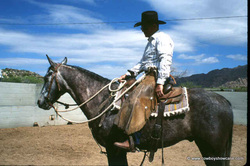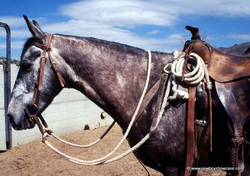Using the McCarty

Horse Training Tips
USES OF THE MCCARTY At one time, Congress, Arizona horse trainer, Twister Heller, used a McCarty (also spelled "mecate") on almost all the horses he trained. The name McCarty refers to a length of rope, from 18 to 30 feet long, used in buckaroo country primarily as a riding rein with an attached lead rope. The rope may be attached to a bosal (hackamore noseband) or to a snaffle bit. McCartys can be made from many different materials including braided horse hair, coreless rope, spun 3/4' nylon rope, or even soft, supple, braided leather. Twister's fondness for a McCarty came from its many additional uses and the fact that it is easier to hang onto than traditional leather reins. He has quit using a McCarty to a great extent riding in the Arizona desert where everything either bites or sticks, because it can be easily pulled out of your hands by the ubiquitous sticker bush. He was very interested by the idea of a supple leather braided McCarty, because it would be immune to most stickers. Twister demonstrated using a McCarty to desensitize horses to a rope, using it to "pull around" a green horse to get it used to a bridle, to lounge a horse, and how to lengthen and shorten the rein for corral work or roping. A McCarty can be used for hobbling or for tying a foot up to doctor or shoe. It can be used for lounging or with a second line for ground driving. McCartys are handy when you are opening or closing gates in pastures. One unusual thing about the McCarty setup used by Twister is the type of leathers used to attach the rope to the rings of the snaffle bit. Most of the leathers used for this purpose (called slobber leathers) are doubled flat with slits to attach the rope. Since Twister likes to easily be able to adjust length and remove the McCarty rope for additional uses, he has devised slobber leathers that are each one continual band of leather made from a strip of leather about 18" long and 1" wide, riveted in the center after being placed around the snaffle ring. Using these wide open leathers, Twister can quickly insert one end of the McCarty, twist it around, and attach or change the length of his rein. 
When using a McCarty two handed, the correct way to adjust your hands comes from sliding a hand either direction from a balanced mid point. The rein part of a McCarty can easily be shortened to be used one handed while roping. Twister demonstrated pulling the rope up in his hand, using his teeth, to shorten the rein. At other times he leaves the rein longer than normal in order to use it to slap a horse back and forth on the neck for quick corral work. While riding Twister will slip the free end of the McCarty through his front chap belt or it may be coiled and tied up with the front left saddle string. When a McCarty is tucked through the chap belt, the rider has the opportunity, should he be unhorsed for any reason, to grab the long lead and keep from being set afoot a long way from home.
A McCarty can also be used to train a colt to drop his nose. Twister tied one end of the McCarty to the right slobber leather, ran the rest between the horse's front legs, behind the right stirrup leather, over the seat of the saddle, behind the left stirrup leather, back between the front legs, and up to the left slobber leather. He adjusted the rope to place a little downward pressure on the horse's mouth and then half-hitched the free end to the saddle horn. The horse was then set free in a round pen for about 15 minutes to learn to drop his head to avoid the pressure. Twister makes sure such sessions are always supervised. This article by Mike Laughlin first appeared in Western Horseman Magazine May, 1998. |
|




